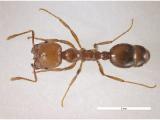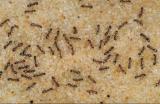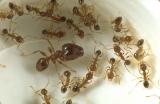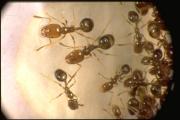Invasive ant species of concern
| Common name Scientific name | Origin | Western Australian (and legal) status | Australian status | Bites or stings? |
|---|---|---|---|---|
| Solenopsis invicta | Pantanal region of Brazil | WA declared free in October 2023. | Localised incursions (Qld and WA) | Painful sting and stings relentlessly when disturbed (Anaphylactic shock in some people) |
| Lepisiota incisa | Africa | Eradication program ongoing
| Localised incursions (WA) | Bites, but not painful to people |
| Lepisiota frauenfeldi | Southern Europe | Eradication program ongoing | Localised incursions (NT, WA, Qld) | Bites, but not painful to people |
| Electric ant (little fire ant) Wasmannia auropunctata
| Central and South America | Not present Prohibited entry into WA | Localised incursions (Qld) | Painful sting |
| Yellow crazy ants Anoplolepis gracilipes 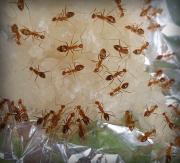 Yellow crazy ants on bait at Cocos (Keeling) Islands. Image courtesy of Marc Widmer. | South East Asia | Not present Prohibited entry into WA | Localised incursions (Qld, NT, Cocos Island and Christmas Island) | Sprays a formic acid that is painful to eyes |
| Tropical fire ant | Mexico, Central/ South America | Not present Prohibited entry into WA | Localised incursions (NT, Tiwi Islands, Christmas Island, Cocos Island, Ashmore Reef) | Powerful sting (Anaphylactic shock rare but has been reported) |
| Linepithema humile | Argentina and South America | Established in WA | Widely established (WA, SA, Vic, NSW, Tas, ACT) | Bites, but not painful to people |
| (Big-headed ants) Pheidole megacephala | Southern and Northern Africa | Established in WA | Widely established (WA, NT, VIC, Qld, NSW) | Stings, but not painful to people |
| Tetramorium bicarinatum | Africa | Established in WA | Established in WA and other states | Painful sting |
| Trichomyrmex destructor
| North Africa | Established in WA | Established in WA, NT, NSW, QLD, VIC | Painful sting |
Other ant species found in Western Australia
Described below are a number of native and introduced ant species which can be problematic for householders, businesses and farming properties alike. This species list is based on the ant samples submitted to PaDIS for identification. It is not a comprehensive list of all ant species in WA. Click the 'hyperlinked' common name of each ant within the table to access our available ant fact sheets or web pages. Refer also to links on the right hand side of this webpage.
| Common Name Scientific name | Native or introduced | Common locations | Bites or stings? |
|---|---|---|---|
| Ochetellus glaber (native to Australia)  Black house ants
| Native | House-infesting and attracted to sweet liquids and foods | Does not bite or sting |
| Bull ants (Bull dog or inch ants) Myrmecia species | Native | Natural and urban areas. Underground nests | Painful sting |
| Cocktail ants (Valentine ants) Crematogaster species 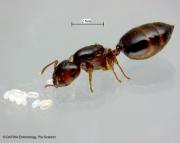 Cocktail ants (Crematogaster species) | Native | Bush land and residential blocks within bush land | Do not bite but can sting |
| Rhytidoponera metallica | Native | Natural and urban areas. Underground nests | Painful sting |
| Iridomyrmex purpureus | Native | Large mounds in open sunny areas | Bites aggressively with jaws |
| Night or Nocturnal ants (native species only, not Carpenter ants) | Native | Nest in old trees, woodpiles and in the ground | Some species will bite |
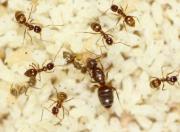 Nylanderia species | Both native and non-native species | Nest in the ground outside. Excavate sand in gardens, lawns and pathways | Harmless and do not sting |
| Iridomyrmex chasei spp. (native to WA) | Native | Nest in the ground, disturb sand in gardens and pathways | Does not sting, but will swarm and bite |
| Technomyrmex species 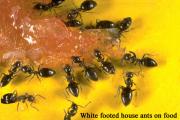 White footed house ants (Technomyrmex jocosus) with food
| Native and introduced species | Nest in roof and wall spaces, electrical equipment, electrical kitchen appliances etc. |
Does not bite or sting |
Tables 1 and 2 were modified from an Australian Government table.
Reporting and sending specimens for identification
Pest ant identification services are provided to the West Australian public for suspect exotic species and problematic ants. Ants can be easily collected using the sticky side of transparent (clear) sticky tape then gently adhering the tape to white paper. Try not to crush the ants. If the ants are too quick for you to catch on the sticky tape, try using fly spray first. Alternatively, brush ants into a labelled container and seal. Place the ant sample in the freezer for 2 hours.
Detailed instructions for sending a range of insects and plants are available (for WA residents and specimens only) on the sending specimens for identification page.
Enter your contact details on the paper:
- Location where the ants were caught.
- Name and contact details of the collector (telephone number/email address).
- Description of the situation, nests and any damage noticed.
Important: Specimens can be delivered or posted to:
Department of Primary Industries and Regional Development
Pest and Disease Information Service
3 Baron Hay Court
South Perth, WA 6151
CAUTION: DO NOT SEND LIVE ANTS IN THE POST! If you suspect exotic pests (e.g. red imported fire ants) send photographs and descriptions to padis@dpird.wa.gov.au or call (08) 9368 3080 for guidance as this could potentially spread the suspect pest.
Book references
Vinson, S.B., 1994. Impact of the invasion of Solenopsis invicta (Buren) on native food webs. In: Williams, D.F. (Ed.), Exotic Ants: Biology, Impact, and Control of Introduced Species. Westview Press, Boulder, CO, pp. 241-258.




